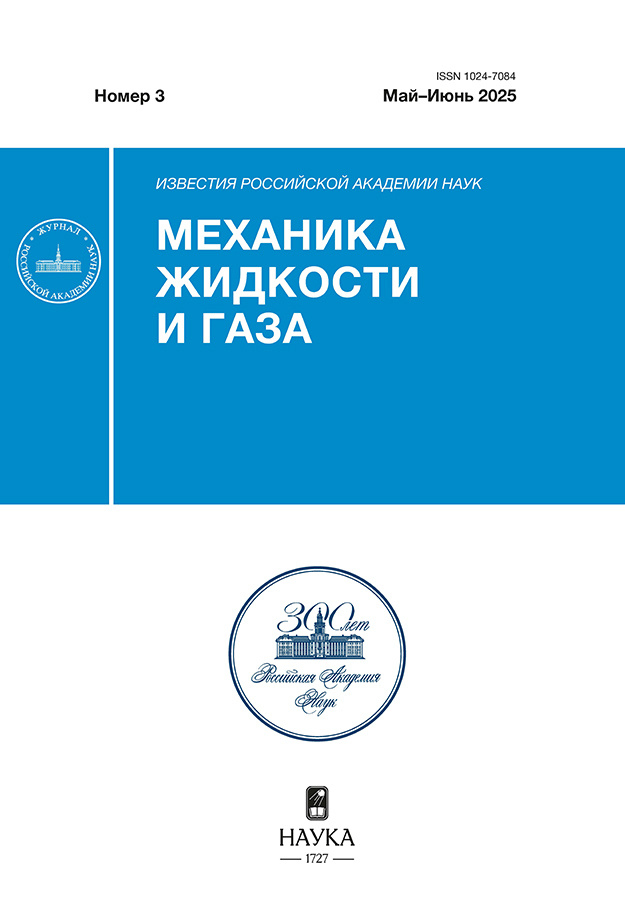Режимы вытеснения из анизотропного пласта при закачке жидкости через вертикальную скважину
- Авторы: Андреева А.И.1, Афанасьев А.А.1
-
Учреждения:
- МГУ им. М. В. Ломоносова
- Выпуск: № 3 (2024)
- Страницы: 137-153
- Раздел: Статьи
- URL: https://kld-journal.fedlab.ru/1024-7084/article/view/682521
- DOI: https://doi.org/10.31857/S1024708424030107
- EDN: https://elibrary.ru/PFEHRR
- ID: 682521
Цитировать
Полный текст
Аннотация
В рамках профильной задачи фильтрации исследуются режимы вытеснения жидкости из пласта, вскрытого системой вертикальных скважин. Рассматривается случай анизотропного пласта, в котором существенен эффект плавучести вытесняющей жидкости. Показано, что в случае общего положения процесс вытеснения характеризуется пятью критериями подобия, один из которых определяет параметры потока жидкости из скважины в пласт. Описаны асимптотические режимы вытеснения, в которых число определяющих параметров подобия снижается. Исследовано влияние этих параметров на коэффициенты извлечения пластовой жидкости и охвата пласта вытеснением. Построена диаграмма режимов вытеснения, в которой ограничены области влияния критериев подобия и обнаруженные асимптотические случаи. Результаты настоящего исследования могут быть полезны в нефтегазовой отрасли при оценке эффективности различных методов разработки месторождений.
Ключевые слова
Полный текст
Об авторах
А. И. Андреева
МГУ им. М. В. Ломоносова
Автор, ответственный за переписку.
Email: waandreeva@gmail.com
Научно-исследовательский институт механики
Россия, МоскваА. А. Афанасьев
МГУ им. М. В. Ломоносова
Email: afanasyev@imec.msu.ru
Научно-исследовательский институт механики
Россия, МоскваСписок литературы
- Желтов Ю.П. Разработка нефтяных месторождений. М.: Недра, 1986. 332 с.
- Afanasyev A., Andreeva A., Chernova A. Influence of oil field production life on optimal CO2 flooding strategies: Insight from the microscopic displacement efficiency // Netherlands: Elsevier BV. JPSE. V.205. 108803.
- Dake L.P. Fundamentals of Reservoir Engineering. ELSEVIER SCIENCE B.V. 1978. 498 p.
- Гиматудинов Ш.К., Ширковский А.И. Физика нефтяного и газового пласта. М.: Недра, 1982. 312 c.
- Семигласов Д.Ю. Эффекты анизотропии при двухфазной фильтрации в сложно построенных коллекторах // Георесурсы, геоэнергетика, геополитика. 2012. № 1 (5). 18 c.
- Fan Z., Cheng L., Yang D., Li X. Optimization of Well Pattern Parameters for Waterflooding in an Anisotropic Formation// Mathematical Geosciences. 2018. V.50. P. 977. 10.1007/s11004-018-9745-y.
- Слабнов В.Д., Султанов Р.А. Численное моделирование вытеснения высоковязкой нефти водой при нелинейном законе фильтрации // Учен. зап. Казан. ун-та. Сер. Физ.-матем. науки. 2016. № 2. C. 276.
- Rodriguez A.X., AristizГЎbal J., Cabrales S., GГіmez J. M., Medaglia A.L. Optimal waterflooding management using an embedded predictive analytical model // Journal of Petroleum Science and Engineering, 2022. V. 208, Part B. 109419. https://doi.org/10.1016/j.petrol.2021.109419
- Андреева А.И., Афанасьев А.А. Метод оптимальной расстановки скважин при разработке нефтяного месторождения // Вестник Московского университета. Сер.: Математика. Механика. 2021. № 2. С. 52–56.
- Чернова А.А., Афанасьев А.А. Режимы вытеснения жидкости из анизотропного пласта в поле силы тяжести // Изв. РАН. МЖГ. 2023. № 6. С. 95–109.
- Мищенко И.Т. Скважинная добыча нефти. М: Нефть и газ, 2003. 816 с.
- Peaceman D.W. Interpretation of Well-block pressures in numerical reservoir simulation with nonsquare grid blocks and anisotropic permeability, SPE, Exxon Production Research Co., 1983. P. 10–12
- Баренблатт Г.И., Ентов В.М., Рыжик В.М. Движение жидкостей и газов в природных пластах. // М.: Недра, 1984. 211с.
- Ермилов О.М., Ремизов В.В., Ширковский Л.И., Чугунов Л.С. Физика пласта, добыча и подземное хранение газа. М.: Наука, 1996. 541 с.
- Brooks R., Corey A. Hydraulic properties of porous media // Hydrology Papers, Colorado State University, 1964. 27p.
- Afanasyev A. Hydrodynamic modelling of petroleum reservoirs using simulator MUFITS // Energy Procedia. 2015. V. 76. P. 427–435.
- MUFITS. Reservoir Simulation Software. [Электронный ресурс]. 2013–2023. URL: http://www.mufits.org/(дата обращения: 12.12.2023)
Дополнительные файлы























